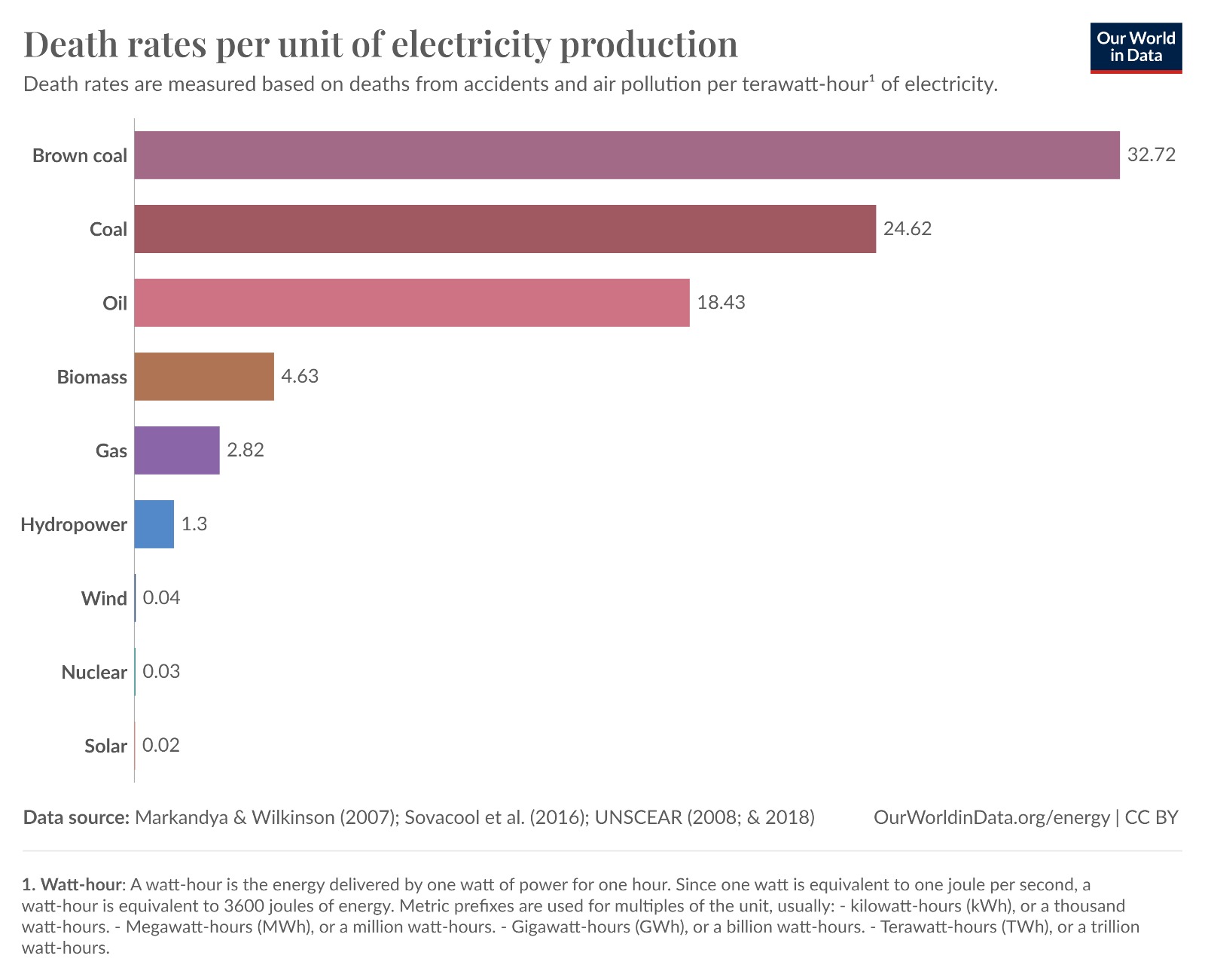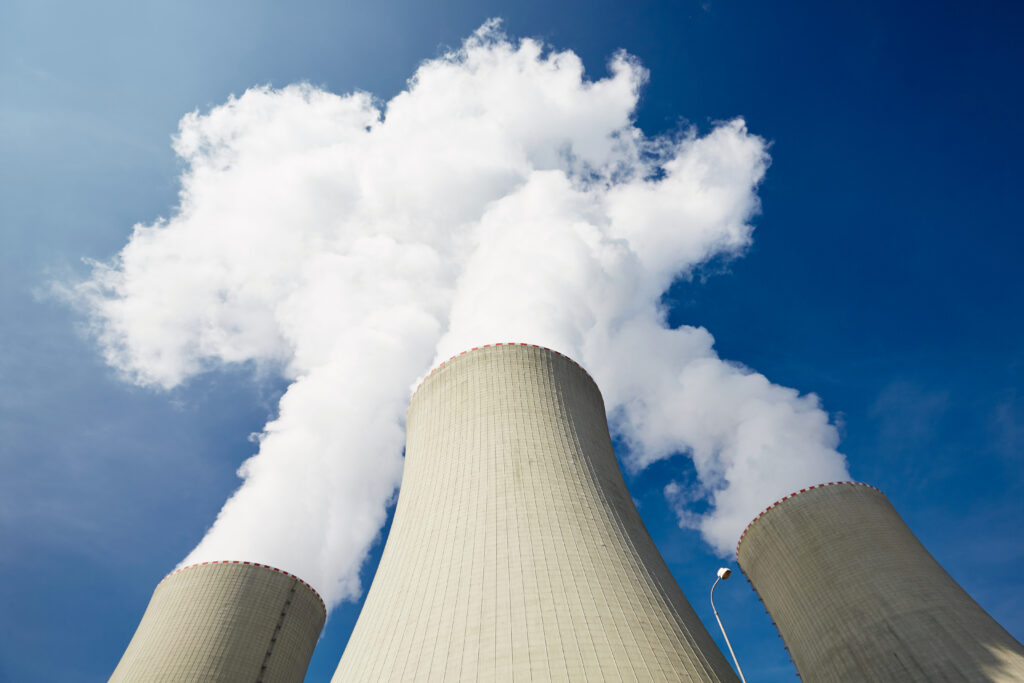Safety always seems to be the biggest question mark around nuclear energy with accidents such as Chernobyl, 26 April 1986, persistently coming up in any debate. A commonly used metric for the safety of energy generation is ‘Death rate per unit of electricity’. Put simply, it is the number of deaths divided by how much energy is generated. When talking about safety, it is key to consider the amount of energy produced, otherwise less-used sources would wrongly appear safer, therefore skewing the data.

Figure 1 (Our World In Data, 2016) is a representation of said metric.
This data includes all deaths due to nuclear accidents, such as Chernobyl and Fukushima, and yet, nuclear is still the second safest form of energy generation. Contrary to what the tabloids will have you believe, it is over 40 times safer than hydroelectric power, almost 100 times safer than the safest fossil fuel (natural gas) and over 1000 times safer than the least safe fossil fuel: brown coal (Kharecha and Hansen, 2013).
It becomes apparent that nuclear energy is not simply safe; it is safer than nearly any other form of generation. Arguments structured around the question of safety to oppose nuclear energy are misleading exaggerations. Instead of being based on facts they are subjective perceptions built by biased campaigns and uncomfortable anecdotes.
Considering all this it is upsetting to see countries outright ruling out nuclear energy. Greece is one such example. Using its predisposition to earthquakes as justification, Greece does not currently wish to look into nuclear energy in the foreseeable future. The accident at Fukushima comes up frequently in these discussions. Fukushima is a city in Japan which contained a nuclear reactor. During the 2011 Japan earthquake and resulting tsunami, one of the 4 reactors melted. However, due to the safety of current reactor technologies, only a single person died due to the radiation leakage into the atmosphere, and none due to the accident itself (www.britannica.com, n.d.).
In addition to this, the reactor melting is not even attributed to the earthquake but rather the tsunami itself, meaning that current nuclear reactor technology is shown to withstand earthquakes much worse than those experienced in Greece. For reference, the Fukushima earthquake was 125 times stronger than the strongest earthquake in Greece since 1950. I believe this accident makes it clear that even in a worst-case scenario, accidents like what most people imagine do not happen with modern reactors and that these new technologies are more than capable of handling the earthquakes that happen in Greece.
What’s more, in addition to being a safe and trustworthy source of energy generation, nuclear energy enjoys other benefits. For one, it does not produce greenhouse gas emissions meaning it does not contribute to climate change. Furthermore, it is nowhere near running out at the speed fossil fuels are. Currently economically accessible uranium will last for at least 230 years without the use of breeder reactors and 30,000 years with the use of breeder reactors (Fetter, 2009). Finally, unlike most forms of renewable energy generation, it generates electricity consistently no matter the weather.
These three advantages make nuclear energy perfect for aiding renewables in combating their biggest problem: variability. Unlike fossil fuel power plants, which can be turned on and off in line with demand, renewable energy systems rely on the weather to produce electricity. This means that, almost always, they will over-generate or under-generate in a renewable-only grid, causing frequent power cuts and power surges.
There are three main ways to solve this problem: storage, larger grids, and other energy sources. Storage technology cannot currently be sustainably scaled up to a national level and making larger grids (i.e having more interconnections with other countries) is only beneficial to the environment if the other countries are also using renewably generated energy. Using other energy sources is what is currently being done, with fossil fuel power plants providing energy whenever renewables are falling short.
Nuclear energy could be used instead of fossil fuels to aid renewables in a similar way (decreasing the percentage of demand met by renewables such that energy storage technology does not need to be at a national scale). Unlike the other solutions which rely on future developments in areas such as storage technology; nuclear energy, as it currently is, can be used (alongside current storage technology) to make a grid which emits virtually no greenhouse gases.
Of course, one should be mindful that there still exist some problems with nuclear energy, the greatest being its production of nuclear waste. This will remain radioactive for thousands of years underground. More research needs to be done into using/treating this waste in an economical way such that it is disposed of.
Due to the dangerous nature of radioactive waste, current nuclear fission technology cannot be used forever and is not a part of a future perfect energy landscape. However, nuclear waste is significantly less harmful to the environment than the 37.4 billion tonnes of CO2 currently being emitted annually by fossil fuel power stations (Glen Peters, 2024). Nuclear energy must be used to phase out fossil fuels and be kept until energy storage technology has improved enough to allow for a renewable-only grid.
A future without nuclear energy is a future with fossil fuels, and nuclear energy is by far the lesser of two evils.
Reference list
Fetter, S. (2009). How long will the world’s uranium supplies last? [online] Scientific American. Available at: https://www.scientificamerican.com/article/how-long-will-global-uranium-deposits-last/ [Accessed 12 Jan. 2025].
Glen Peters (2024). Fossil fuel CO2 emissions increase again in 2024. [online] Global Carbon Budget. Available at: https://globalcarbonbudget.org/fossil-fuel-co2-emissions-increase-again-in-2024/ [Accessed 12 Jan. 2025].
Pushker Kharecha and James Hansen (2013). Coal and Gas are Far More Harmful Than Nuclear Power. National Aeronautics and Space Administration (NASA).
Our World In Data (2016). Death rates from energy production per TWh. [online] Our World in Data. Available at: https://ourworldindata.org/grapher/death-rates-from-energy-production-per-twh.
Rafferty, J.P. and Pletcher, K. (2019). Japan earthquake and tsunami of 2011 – Aftermath of the disaster. In: Encyclopædia Britannica. [online] Britannica. Available at: https://www.britannica.com/event/Japan-earthquake-and-tsunami-of-2011/Aftermath-of-the-disaster [Accessed 9 Jan. 2025].
www.britannica.com. (n.d.). Did anyone die as a result of the Fukushima accident? | Britannica. [online] Available at: https://www.britannica.com/question/Did-anyone-die-as-a-result-of-the-Fukushima-accident [Accessed 20 Jan. 2025].








